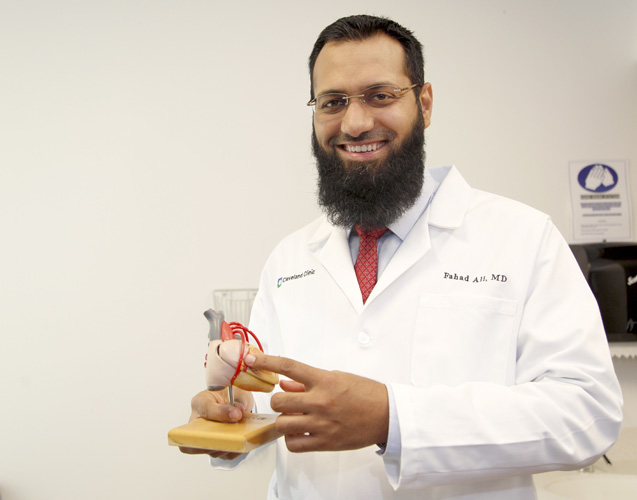
Heart rhythm disorders known as arrhythmias can and do cause a wide variety of problems that range from the inconvenient (momentary dizziness or fatigue) to the fatal (stroke and sudden death).
And, unfortunately, as the University of Maryland medical school points out, “arrhythmias become more and more common as we age and are the leading cause of sudden cardiac death with 400,000 victims a year.”
Dr. Fahad Ali, a clinical cardiac electrophysiologist who recently joined the Welsh Heart Center team at Cleveland Clinic Indian River Hospital, is well aware of those statistics, adding that atrial fibrillation is “one of the most common heart rhythm problems.”
So, what exactly does a clinical cardiac electrophysiologist do to diagnose and treat the various types of arrhythmias?
Columbia University and the Mount Sinai Medical Center say “cardiac electrophysiology is a field of medicine entirely devoted to the detection and treatment of heart rhythm disorders.”
The American College of Cardiology adds that electrophysiologists “fuse different fields in cardiology and work in close relationship with cardiac imaging. That requires the expertise of multiple diagnostic modalities, such as echocardiography, cardiac computerized tomography, fluoroscopy, cardiac magnetic resonance imaging and electroanatomic mapping. Each of these modalities provides valuable information about the underlying mechanism of the arrhythmia.”
The American Heart Association puts its description in simpler terms: “When someone’s heart doesn’t beat normally, doctors use electrophysiology studies or EPS to find out why. Electrical signals usually travel through the heart in a regular pattern. However, heart attacks, aging and high blood pressure may cause scarring of the heart. This may cause the heart to beat in an irregular or uneven pattern,” and electrophysiologists work to detect and treat the source of those irregular patterns.
One of the most common techniques for treating the faulty electrical patterns is catheter ablation.
In this procedure, the doctor threads one or more long, thin tubes (catheters) through blood vessels to your heart. He or she then uses a mapping catheter to determine where the triggers are located and applies extreme cold or heat with the catheter tips to destroy or ‘ablate’ those spots. This causes scarring that disrupts the faulty electrical signals and restores normal heart rhythms.
If the heart is beating too slowly it’s called bradycardia. If the heart is beating rapidly – over 100 beats per minute – it’s called tachycardia. If the heart has an irregular (and often rapid) beating rate, it’s called atrial fibrillation – the most common form of arrhythmia.
The Mayo Clinic estimates 2.7 million Americans have atrial fibrillation (AFib).
“When our heart is contracting, it’s pumping the blood to different parts of the body,” says Ali. “In atrial fibrillation, the top chambers of the heart do not contract properly and, as a result, the blood is basically stagnating in the top chambers.”
That, he says, can lead to blood clots which can travel to other parts of the body and cause strokes. Or worse.
“What we [clinical cardiac electrophysiologists] do is we go inside the heart, most of the time, almost all the time, through the groin, from the veins, not from the arteries,” Ali continues.
“We go to the top right chamber first and put in different catheters. We put a camera in there, which is an ultrasound camera, to take pictures. We have a 3D electro-anatomic mapping system set up in the room. And we also have X-ray cameras. So, using ultrasound, X-rays, 3D electro-anatomic mapping system, using that guidance, we then go to the top left chamber of the heart.”
These procedures can be both exploratory and curative, as Ali explains.
“We check electrical signals,” being sent from the heart. “Most of the time we know where the atrial fibrillation comes from. So, we zap those areas using the same catheters and then we check more signals, make sure the job is done and that we have achieved what we wanted to achieve. And once we are done, we pull out all the catheters.”
Of course, ‘zapping’ areas of the heart may not sound like a great idea but, as Ali explains, “the tissues that we burn inside the heart are apparently healthy tissues, but they’re part of the abnormal electrical circuit.”
By ablating those particular pieces of tissue, the heart can return to its normal rhythm and the patient to a normal life in less time than you might imagine.
“The average duration time for ablation procedures is roughly about two hours plus or minus. It can be a little bit quicker. It can be a little bit longer,” Ali says.
“If everything goes fine, some of the patients can leave the hospital the same day in the evening. Other people prefer to stay overnight and depending on the case, sometimes we like to keep them overnight and send them home next morning.”
Most of the patients Ali expects to see will come from referrals from primary cardiologists or internal physicians, though he says that “once in a while we do get self-referred patients, as well.”
Dr. Fahad Ali is a clinical cardiac electrophysiologist with the Cleveland Clinic Indian River Hospital and the Welsh Heart Center. His office is in the hospital’s Health & Wellness Center at 3450 11th Court, Suite 104 in Vero Beach. The phone number is 772-226-4830.



